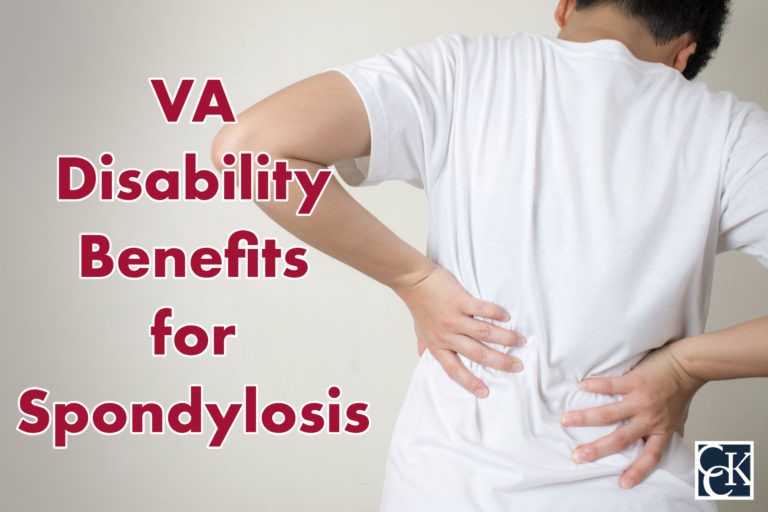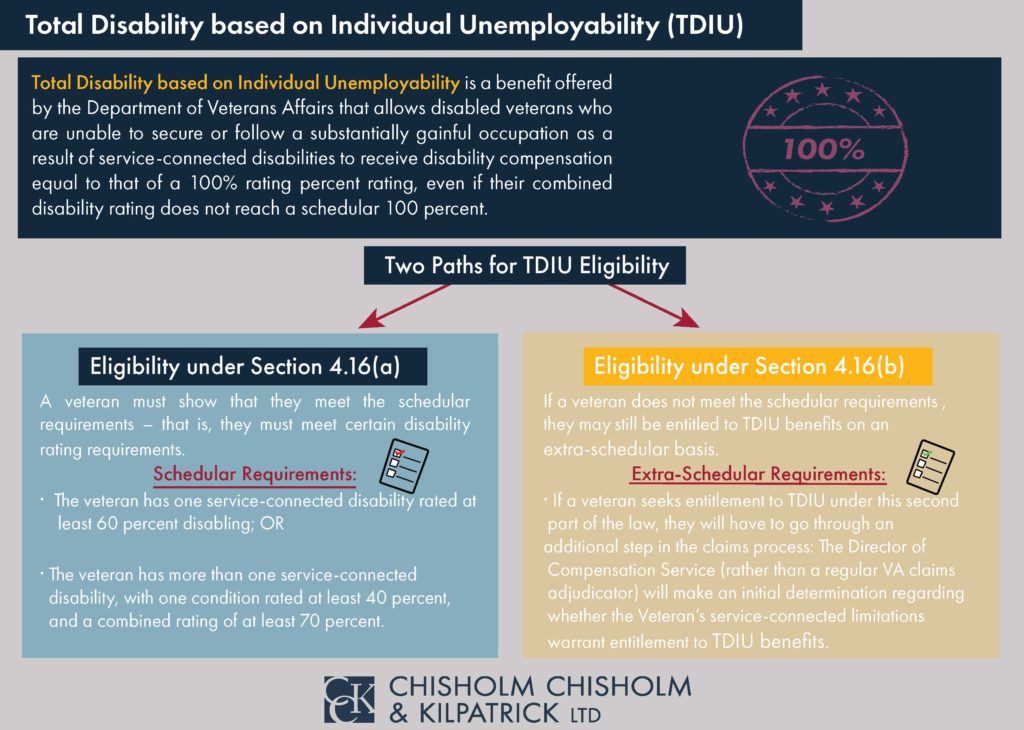VA Disability Benefits for Spondylosis

CCK Law: Our Vital Role in Veterans Law
What is Spondylosis?
Spondylosis is a form of degenerative disease that can affect the spine and neck. The condition affects the discs and vertebrae, or bones, of the spine. It can affect any part of the spine, meaning different people may have different types of spondylosis. For example, if a person’s spondylosis affects the neck, they may have cervical spondylosis; alternatively, lumbar spondylosis affects the low back. There is also lumbosacral spondylosis which affects the sacrum area of the back and thoracic spondylosis, affecting the mid back. Cervical and lumbar spondylosis are generally the two most common forms of the condition.
Symptoms of Spondylosis
- Pain or stiffness in the affected part of the spine
- Soreness
- Muscle spasms
- Dizziness
- Headaches
- Clicking or popping sound when moving
- Radiating, intermittent pain that can spread to the extremities
- Tingling in the back, buttocks, or legs
- Tenderness
- Loss of bowel or bladder function
Diagnosing Spondylosis
A physical exam is most often needed in order to diagnose spondylosis. A doctor can examine the range of motion a person has, if their reflexes are working properly, and if their motor skills are functioning as they should. Additionally, imaging tests can help confirm a diagnosis of spondylosis. Such imaging tests may include:
- X-rays
- CT scans
- MRI
- Myelography
- EMG
- Nerve conduction tests
Treatment Options
The treatment for a person’s spondylosis can be determined by the severity of their symptoms. A doctor can usually help a person determine the treatment plan that is right for them. The goal of such treatment plans is usually to relieve pain and limit symptoms, as well as preventing future damage to the spine. Some forms of treatment may include:
- Pain medication
- Physical therapy
- Injections
- Surgeries, such as spinal fusion, discectomy, and laminectomy
- Some forms of lifestyle changes like weight loss or increased exercise
VA Service Connection for Spondylosis
To establish service connection for spondylosis, VA usually requires the veteran to submit three things:
- A diagnosis of spondylosis;
- An in-service event or stressor which caused or aggravated the spondylosis;
- A nexus, which links the veteran’s spondylosis to their service
Veterans can submit a claim for service connection on VA From 21-526EZ. The form can be submitted to VA in the following ways:
- Online – using VA’s eBenefits platform
- By mail – directed to the Department of Veterans Affairs, Evidence Intake Center, PO Box 4444 in Janesville, WI 53547-4444
- In person – bringing a completed VA Form 21-526EZ to a VA Regional Office near you
- With a legal representative – completing the form with a Veterans Service Organization (VSO) or a VA accredited agent or attorney

VA Ratings for Spondylosis
Spondylosis is rated as a back condition, meaning it can be rated using any diagnostic code between Diagnostic Code 5235 and Diagnostic Code 5243. Specifically, the condition will be rated on how it impacts the motion of the spine. All diagnostic codes for back injuries or conditions are rated using General Rating Formula for Diseases and Injuries of the Spine under 38 CFR § 4.71a.
For example, if a veteran’s spondylosis impacts their lower back and limits their motion greater than 15 degrees, but not more than 30 degrees, they would most likely be rated at 20 percent. Listed below are the ratings for lower back pain:
- 100% – unfavorable ankylosis of the entire spine
- 50% – unfavorable ankylosis of the entire thoracolumbar spine
- 40% – unfavorable ankylosis of the entire cervical spine; or, forward flexion of the thoracolumbar spine 30 degrees or less; or, favorable ankylosis of the entire thoracolumbar spine
- 30% – forward flexion of the cervical spine 15 degrees or less; or, favorable ankylosis of the entire cervical spine
- 20% – forward flexion of the thoracolumbar spine greater than 30 degrees but not greater than 60 degrees; or, forward flexion of the cervical spine greater than 15 degrees but not greater than 30 degrees; or, the combined range of motion of the thoracolumbar spine not greater than 120 degrees; or, the combined range of motion of the cervical spine not greater than 170 degrees; or, muscle spasm or guarding severe enough to result in an abnormal gait or abnormal spinal contour such as scoliosis, reversed lordosis, or abnormal kyphosis
- 10% – forward flexion of the thoracolumbar spine greater than 60 degrees but not greater than 85 degrees; or, forward flexion of the cervical spine greater than 30 degrees but not greater than 40 degrees; or, combined range of motion of the thoracolumbar spine greater than 120 degrees but not greater than 235 degrees; or, combined range of motion of the cervical spine greater than 170 degrees but not greater than 335 degrees; or, muscle spasm, guarding, or localized tenderness not resulting in abnormal gait or abnormal spinal contour; or, vertebral body fracture with loss of 50 percent of more of the height.
Compensation and Pension Exams for Spondylosis
After a veteran files a claim, VA may request that they attend an exam. One of the main reasons VA may request a Compensation and Pension (C&P) exam for spondylosis is to examine how the condition affects the veteran’s range of motion. Another reason may be to ask how often the veteran experiences incapacitating episodes of pain.
Compensation & Pension exams are performed VA physicians or VA contracted physician. Prior to the exam, the examiner will review the veteran’s c-file so they are familiar with the veteran’s background. Then, during the exam, the examiner may physically examine the veteran and ask questions regarding their condition or their service. The purpose of the exam is to determine if service connection is warranted and, if so, gather evidence to issue a rating.
TDIU and Spondylosis
If service connection is awarded for the veteran’s spondylosis and a rating is given, that rating can help contribute to a veteran’s eligibility for TDIU. TDIU, or total disability based on individual unemployability, is a monthly benefit available to veterans who are unable to work on account of their disability, or disabilities. This benefit compensates veterans at the 100 percent rating level, even if their overall combined rating level is less than that.
In order to be eligible for Schedular TDIU, veterans must have one condition rated at 60 percent minimum OR two conditions that can be combined to reach 70 percent, where one condition is at minimum 40 percent. The criteria for schedular TDIU is outlined under 38 CFR § 4.16a. A rating given for spondylosis can help contribute to a veteran’s eligibility for TDIU.
Veterans who do not meet the necessary criteria for schedular TDIU may be eligible for extraschedular TDIU. For this form of TDIU, veterans must prove that their condition(s) uniquely hinder their ability to maintain substantially gainful employment. Extraschedular TDIU is rated under 38 CFR § 4.16b.

Need Help Getting VA Benefits for Spondylosis?
VA disability benefits for spondylosis can be very complicated, especially since the condition does not have its own diagnostic code. Additionally, many back conditions rely heavily on evidence collected during Compensation & Pension exams, specifically, the range of motion measurements. If a veteran has a negative C&P exam, it can significantly impact their likelihood to receive the rating they deserve.
If you need help with your appeal for benefits for spondylosis, help is available to you. Contact Chisholm Chisholm & Kilpatrick today for a free case evaluation.
About the Author
Share this Post
